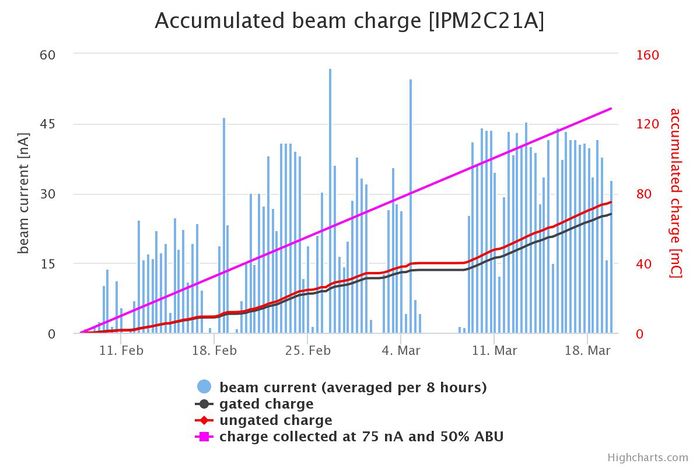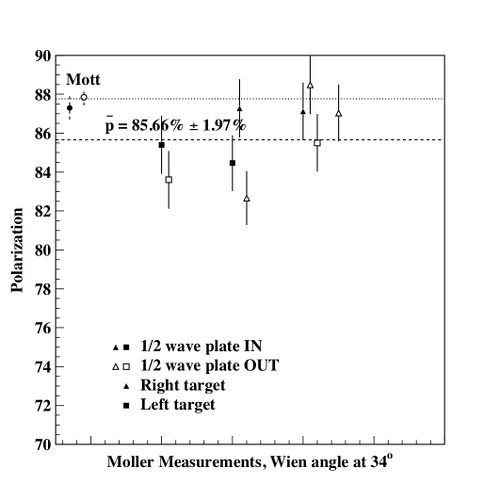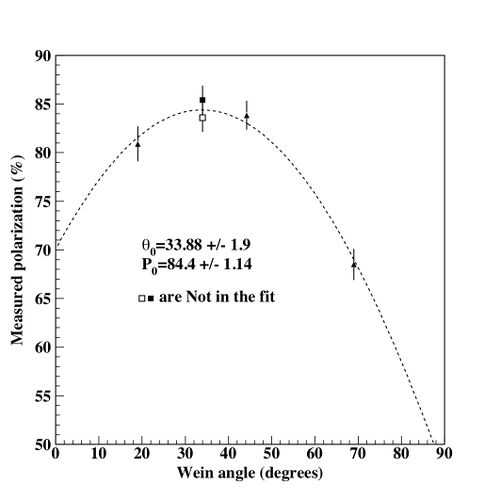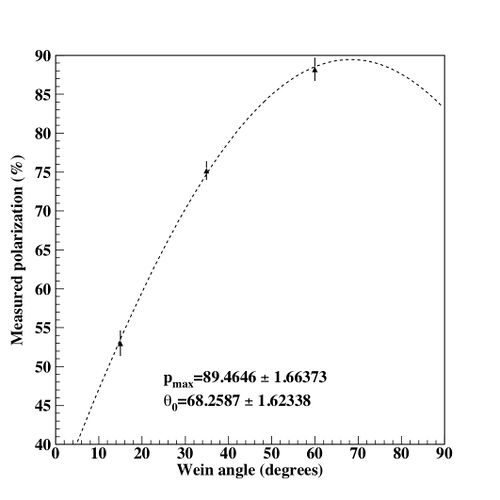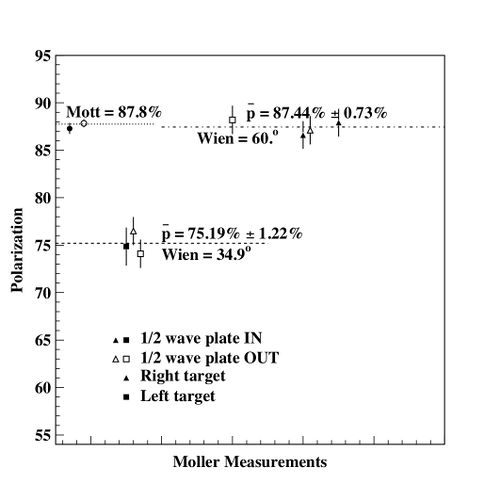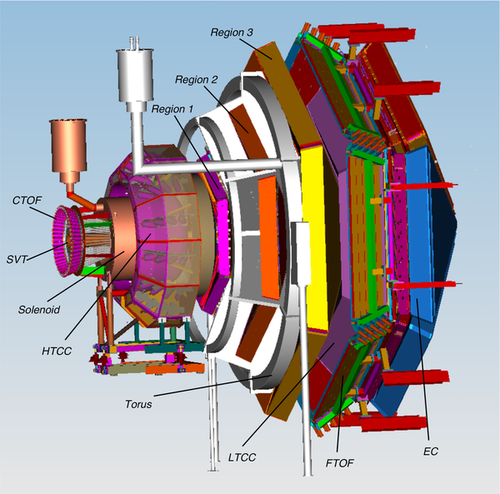Difference between revisions of "Run Group B"
| (426 intermediate revisions by 16 users not shown) | |||
| Line 18: | Line 18: | ||
* [https://clasweb.jlab.org/wiki/images/9/97/Ops_manual_cnd.pdf CND] | * [https://clasweb.jlab.org/wiki/images/9/97/Ops_manual_cnd.pdf CND] | ||
* [https://clasweb.jlab.org/wiki/images/c/c1/Shift_Worker_Manual_January_2018.pdf Cryo-Target] | * [https://clasweb.jlab.org/wiki/images/c/c1/Shift_Worker_Manual_January_2018.pdf Cryo-Target] | ||
| − | * [https:// | + | * [https://www.jlab.org/Hall-B/ctof/notes/ctof_manual.pdf CTOF] |
* [https://clasweb.jlab.org/wiki/images/a/ab/Opman_master.pdf DAQ] | * [https://clasweb.jlab.org/wiki/images/a/ab/Opman_master.pdf DAQ] | ||
* [https://clasweb.jlab.org/wiki/images/b/b2/Drift-chamber-operating-procedure.pdf DC] | * [https://clasweb.jlab.org/wiki/images/b/b2/Drift-chamber-operating-procedure.pdf DC] | ||
* [https://clasweb.jlab.org/wiki/images/a/a2/Ec_manual.pdf ECAL] | * [https://clasweb.jlab.org/wiki/images/a/a2/Ec_manual.pdf ECAL] | ||
* [https://clasweb.jlab.org/wiki/images/3/3b/FT-Manual.pdf FT] | * [https://clasweb.jlab.org/wiki/images/3/3b/FT-Manual.pdf FT] | ||
| − | * [https:// | + | * [https://www.jlab.org/Hall-B/ftof/notes/ftof_manual.pdf FTOF] |
* [https://clasweb.jlab.org/wiki/images/f/f1/HTCC_MANUAL.pdf HTCC] | * [https://clasweb.jlab.org/wiki/images/f/f1/HTCC_MANUAL.pdf HTCC] | ||
* [https://wiki.jlab.org/clas12-run/images/d/d2/Ltcc_manual.pdf LTCC] | * [https://wiki.jlab.org/clas12-run/images/d/d2/Ltcc_manual.pdf LTCC] | ||
| Line 31: | Line 31: | ||
* [[Media:clas12controls_shift.pdf|Slow Controls]] | * [[Media:clas12controls_shift.pdf|Slow Controls]] | ||
* [https://clasweb.jlab.org/wiki/images/d/dc/Hall_B_Solenoid_Power-Up_and_Power-Down_Procedure.pdf Solenoid Power-Up and Power-Down Procedure] | * [https://clasweb.jlab.org/wiki/images/d/dc/Hall_B_Solenoid_Power-Up_and_Power-Down_Procedure.pdf Solenoid Power-Up and Power-Down Procedure] | ||
| − | * [https:// | + | * [[Media:Svt_operation_manual_v1_7.pdf | SVT]] To switch on SVT see [https://logbooks.jlab.org/files/2018/10/3615766/svt_problem_solving_0.pdf SVT short] |
* [https://clasweb.jlab.org/wiki/images/d/d6/Hall_B_Torus_Power-Up_and_Power-Down_Procedure.pdf Torus Power-Up and Power-Down Procedure] | * [https://clasweb.jlab.org/wiki/images/d/d6/Hall_B_Torus_Power-Up_and_Power-Down_Procedure.pdf Torus Power-Up and Power-Down Procedure] | ||
| Line 53: | Line 53: | ||
| valign=top | | | valign=top | | ||
===RC schedule=== | ===RC schedule=== | ||
| − | * | + | * Nov 20 - Nov 27: S. Stepanyan |
| − | * | + | * Nov 27 - Dec 4: M. Contalbrigo |
| − | * | + | * Dec 4 - Dec 11: D. Sokhan |
| − | * | + | * Dec 11 - Dec 18: S. Niccolai |
| − | * | + | * Dec 18 - Dec 20 S. Stepanyan |
| − | * | + | * Jan 7 - Jan 15: J. Gilfoyle |
| − | * | + | * Jan 15 - Jan 22: F. Hauenstein /W. Phelps |
| + | * Jan 22 - Jan 30: B. McKinnon | ||
</font> | </font> | ||
| Line 70: | Line 71: | ||
[https://wiki.jlab.org/clas12-run/index.php?title=Template:PhoneNumbers&action=edit Click Here] to edit Phone Numbers. Note, you then also have to [https://wiki.jlab.org/clas12-run/index.php?title=Run_Group_B&action=edit§ion=11 edit this page] to force a refresh. | [https://wiki.jlab.org/clas12-run/index.php?title=Template:PhoneNumbers&action=edit Click Here] to edit Phone Numbers. Note, you then also have to [https://wiki.jlab.org/clas12-run/index.php?title=Run_Group_B&action=edit§ion=11 edit this page] to force a refresh. | ||
| − | <!-- JUST MODIFY AND SAVE ANYTHING IN THIS COMMENT BLOCK TO FORCE A REFRESH OF THE PHONE NUMBERS | + | <!-- JUST MODIFY AND SAVE ANYTHING IN THIS COMMENT BLOCK TO FORCE A REFRESH OF THE PHONE NUMBERS TEMPLATE--> |
= Short Term Schedule = | = Short Term Schedule = | ||
<!--####################################### SHORT TERM ################################################--> | <!--####################################### SHORT TERM ################################################--> | ||
<center><font color=blue size=4> | <center><font color=blue size=4> | ||
| − | ''' CLAS12 Run Group B, | + | ''' CLAS12 Run Group B, December 2019 - January 2020 </font> '''<br> |
| − | ''' Beam energy 10. | + | ''' Beam energy ~10.4 GeV (5 pass) '''<br> |
''' Important: Document all your work in the logbook! '''<br> | ''' Important: Document all your work in the logbook! '''<br> | ||
| − | ''' Remember to fill in the [https://docs.google.com/spreadsheets/d/ | + | <!---''' Remember to fill in the [https://docs.google.com/spreadsheets/d/17U7tyDwf1j9sdd4vd6g4ZQdKkDw3WNsdIuBRhiWy6CE/edit?usp=sharing run list] at the beginning and end of each run (clas12run@gmail.com can fill the run list)'''<br> ---> |
</center> | </center> | ||
| − | == RC: | + | == RC: Bryan McKinnon == |
* (757) 575-7540 | * (757) 575-7540 | ||
* 9 575 7540 from Counting Room | * 9 575 7540 from Counting Room | ||
| − | * [mailto: | + | * [mailto:mckinnon@jlab.org mckinnon@jlab.org] |
== PDL: Maurizio Ungaro == | == PDL: Maurizio Ungaro == | ||
| Line 92: | Line 93: | ||
<br> | <br> | ||
| + | |||
{| {{TableStyle1}} | {| {{TableStyle1}} | ||
| valign=top width=50% | | | valign=top width=50% | | ||
| + | == <font color=blue>''' Run Plan: Jan 29 - 30 2020 '''</font>== | ||
| − | + | * Wednesday | |
| − | + | ** Owl - Production data at 50nA | |
| + | ** Day - Production data at 50nA | ||
| + | ** Swing - Production data at 50nA | ||
| − | + | *Thursday | |
| − | + | ** Owl - Production data at 50nA | |
| + | ** 7am Request Restricted Access, Ramp Down the magnets, Empty and warm up target | ||
| + | ** 7am Contact Eugene as soon as beam off | ||
| − | |||
| − | |||
| − | 1) | + | * Please note that we have added two items to the list of tasks for each run. |
| + | ** (1) When you collect the gui snapshots for the logbook (scalar gui, FTC Asym plot, livetime, ROC rates, beamline stripcharts) <b>include the DAQ gui</b> AND make sure the snapshot is taken when you're running. We want to record the rate plots on the DAQ gui. | ||
| + | ** (2) Measure the <b>trigger structure</b> (trigger-time distribution) about every 30 minutes and at least once per run enter the results in the logbook. See below for instructions. This is needed to monitor the injector laser phase which created serious problems last week. | ||
| + | * If the trigger-time distribution or region 1 DC occupancies get worse ( > 6.5%) call the RC. What we will likely do is reduce the beam and restart. | ||
| + | * At some later time we need to do an empty target run. Current will be 150 nA for 50M triggers which should take 2-3 hours. | ||
| + | ------ | ||
| + | '''DAQ config: <b>PROD66</b> | ||
| − | + | '''Trigger file : rgb_inbending_v9_1.trg ''' | |
| − | |||
| − | |||
| − | + | <b> Compare the monitoring histograms </b> <!-- from [https://clas12mon.jlab.org/mon12/histograms/?reference=3748541 clas12mon] to the reference and troubleshoot as needed.--> | |
| − | + | ||
| − | |||
| − | <b> | + | <b> Run database: </b> <font color=red>when starting/stopping a run, enter (or check if already present) the requested current in the pop-up window and put RELEVANT COMMENTS (eg: "production run", "trigger test vXX, changed this and that" not just "run") -- <b> please label junk runs </b> if you get the chance. Please also keep a record of run numbers and their conditions in the shift summary. </font> The information you enter in the dialogue box goes directly into the [https://clasweb.jlab.org/rcdb run database] -- it's our primary source of run info and mistakes are hard to correct a posteriori. |
| − | |||
| − | |||
| − | |||
| − | + | Please run the script to look at <b> trigger structure </b> once per shift and check that you get a smooth distribution. Instructions are here: [https://logbooks.jlab.org/entry/3760614] | |
| − | + | Keep an eye on <b> CND channel S14L1R </b> -- it's a bit temperamental. If it trips, switch HV off and on again for it and make an entry in the log book. | |
| − | + | ------ | |
| − | + | '''<b> At the end of each run, follow the <font color=red>STANDARD DAQ RESTART SEQUENCE</font> ''' </b>'''<br> | |
| + | This needs to be followed at the end of every run. Note: this might be different from the instructions coming up on RunControl. | ||
| + | <b><font color=red> | ||
| + | * "end run", "cancel", "reset" | ||
| + | * if the run ended correctly: | ||
| + | ** '''"download", "prestart", "go"''' | ||
| + | * if the run did not end correctly or if any ROCs had to be rebooted: | ||
| + | ** "configure", "download", "prestart", "go" | ||
| + | * After each step, make sure it completed in the Run Control message window.</font></b> If a ROC has crashed, find which one it is, issue a roc_reboot command ON JUST THAT ROC and try again. Contact the DAQ expert if there are any questions. | ||
| − | |||
| − | + | == <font color=blue>''' References and Standards:'''</font>== | |
| − | + | ''(last update 1/14/2020- 23:20)'' | |
| − | |||
| − | |||
| − | |||
| − | |||
| − | |||
| − | |||
| − | |||
| − | |||
| − | |||
| − | |||
<b> Nominal Beam Positions </b> | <b> Nominal Beam Positions </b> | ||
| − | *2H01, X: + | + | *2H01, X: +1.0 mm, Y: -2.6 mm |
| − | *2C24, X: | + | *2C21, X: 0.0 mm, Y: 0.2 mm |
| + | *2C24, X: -0.3 mm, Y: -0.8 mm | ||
<b> FSD Thresholds </b> | <b> FSD Thresholds </b> | ||
* Upstream: 2000 Hz | * Upstream: 2000 Hz | ||
* Midstream: 2000 Hz | * Midstream: 2000 Hz | ||
| − | * Downstream: | + | * Downstream: 700000 Hz |
| − | * BOM: | + | * BOM: 60000 |
| + | |||
| + | <b> Reference Harp Scans for Beam on Faraday Cup: </b> 2C21 [https://logbooks.jlab.org/entry/3759969], 2C24 (tagger harp) [https://logbooks.jlab.org/entry/3759229], 2H01 [https://logbooks.jlab.org/entry/3759255] | ||
| − | <b> Reference Harp Scans for Beam on Tagger | + | <b> Reference Harp Scans for Beam on Tagger dump: </b> 2C21 [https://logbooks.jlab.org/entry/3759158], 2C24 (tagger harp) [https://logbooks.jlab.org/entry/3759160] |
| − | <b> Reference | + | <b> Reference Monitoring Histograms (40 nA, production trigger) </b> [https://logbooks.jlab.org/entry/3748541] |
| − | <b> | + | <b> Counter rates </b> |
| + | * Upstream counters integrated rates: 0-15 Hz (acceptable up to 100 Hz are acceptable) @50 nA. | ||
| + | * Midstream counters: 10-20 Hz (acceptable up to 50 Hz) @50 nA. | ||
| + | * Counting rates of ~ hundreds of Hz may indicate bad beam tune or bleed-through from other Halls. | ||
| − | <b> | + | <b> Beamline vacuum: </b> should be not higher than 5e-5. |
| + | <!--- | ||
<b> Reference Scalers and Halo-Counter Rates: </b> | <b> Reference Scalers and Halo-Counter Rates: </b> | ||
| − | * Well-tuned CW beam on FC, Full LD2 target, CLAS12 ON: 5 nA [https://logbooks.jlab.org/entry/3649861], 10 nA [https://logbooks.jlab.org/entry/3649888], 20 nA [https://logbooks.jlab.org/entry/3649905], 30 nA [https://logbooks.jlab.org/entry/3649916], 40 nA [https://logbooks.jlab.org/entry/3649938], 50 nA [https://logbooks.jlab.org/entry/3649959], 60 nA [https://logbooks.jlab.org/entry/3649970], 75 nA [https://logbooks.jlab.org/entry/3649985] | + | * Well-tuned CW beam on FC, Full LD2 target, CLAS12 ON (Feb 2019): 5 nA [https://logbooks.jlab.org/entry/3649861], 10 nA [https://logbooks.jlab.org/entry/3649888], 20 nA [https://logbooks.jlab.org/entry/3649905], 30 nA [https://logbooks.jlab.org/entry/3649916], 40 nA [https://logbooks.jlab.org/entry/3649938], 50 nA [https://logbooks.jlab.org/entry/3649959], 60 nA [https://logbooks.jlab.org/entry/3649970], 75 nA [https://logbooks.jlab.org/entry/3649985] |
| − | * Well-tuned CW beam on FC, Empty Target, CLAS12 OFF: 5 nA [https://logbooks.jlab.org/entry/3649436] | + | * Well-tuned CW beam on FC, Empty Target, CLAS12 OFF (Feb 2019): 5 nA [https://logbooks.jlab.org/entry/3649436] |
| − | * Well-tuned beam during Moller run [https://logbooks.jlab.org/entry/3649364] | + | * Well-tuned beam during Moller run (Feb 2019) [https://logbooks.jlab.org/entry/3649364] |
| − | * Well-tuned beam on Tagger Dump at 5 nA during harp scans: [https://logbooks.jlab.org/entry/3649358] | + | * Well-tuned beam on Tagger Dump at 5 nA during harp scans (Feb 2019): [https://logbooks.jlab.org/entry/3649358] |
| + | * Reference FTC histogram for 5 nA running (Feb 2019): [https://logbooks.jlab.org/entry/3665122] | ||
| − | <b> SVT acceptable currents: </b> <10 nA (typically < 1 nA) with no beam and no HV; ~< 400 nA (HV ON, no beam); 10 nA [https://logbooks.jlab.org/entry/3649889], 20 nA [https://logbooks.jlab.org/entry/3649911], 30 nA [https://logbooks.jlab.org/entry/3649920], 40 nA [https://logbooks.jlab.org/entry/3649941], 50 nA [https://logbooks.jlab.org/entry/3649960], 60 nA [https://logbooks.jlab.org/entry/3649972], 75 nA [https://logbooks.jlab.org/entry/3649986] | + | <b> SVT acceptable currents (Feb 2019): </b> <10 nA (typically < 1 nA) with no beam and no HV; ~< 400 nA (HV ON, no beam); 10 nA [https://logbooks.jlab.org/entry/3649889], 20 nA [https://logbooks.jlab.org/entry/3649911], 30 nA [https://logbooks.jlab.org/entry/3649920], 40 nA [https://logbooks.jlab.org/entry/3649941], 50 nA [https://logbooks.jlab.org/entry/3649960], 60 nA [https://logbooks.jlab.org/entry/3649972], 75 nA [https://logbooks.jlab.org/entry/3649986] |
| + | ---> | ||
| − | = | + | | valign=top | |
| − | |||
| − | < | + | ==<font color=blue>''' General Instructions''':</font>== |
| − | |||
| − | |||
| + | * The <b> main lights in the Hall </b> (dome lights) and the Forward Carriage lights are being kept off because of light leaks affecting some of the detectors. If these lights are switched on during an access, they should be switched off when leaving the Hall. Note that the dome lights when switched off cannot be turned back on immediately because they require 10-15 min to cooldown. | ||
| + | * Do not run more than 30 minutes above 30 nA with 5-pass beam without the <b> beam blocker in front of Faraday cup </b>. Put beam blocker in for long running at high currents for 5 pass operations. | ||
| + | * Turn <b> DC HV </b> off only for beam tuning; if no beam is available or when beam is stable, keep them on even if you are not taking data. | ||
| + | * In case of loss of communication with <b> IOCBTARG </b>, follow instructions at https://logbooks.jlab.org/entry/3502218 | ||
| + | * With any issue contact On-Call Experts or RC - <b> do not spend more than 15-20 min trying to fix the problem</b>. If the phone is not answered, try the "Page Experts" button on top of CLASCSS. | ||
| + | * Check for and read any comments to log-book entries made during your shift! | ||
| − | |||
| − | |||
| − | |||
| − | + | '''Every Shift:''' | |
| + | * Follow run plan as outlined by RC | ||
| + | * If any concern about beam stability, ask MCC if orbit locks are on (they should be). | ||
| + | * Keep shift summary up to date in HBLOG. Record all that happens. | ||
| + | * Document any beam condition change and send scaler GUIs to HBLOG | ||
| + | * [https://bta.acc.jlab.org Fill out BTA] hourly. Click "Load from EPICS" to automatically fill the left side. Run the script <font color=red>btaGet.py</font> to print for you the correct BTA info for this hour -- edit the values on the BTA page if they are wrong! | ||
| + | * Upload spectra from clas12mon at begin and end of shift and cross-check with reference spectra (make sure you select the SAME SECTOR as for the reference plots on tabs which have multiple sectors). | ||
| + | ** Reset clas12mon every ~2 hours and inspect spectra (some detectors have buttons at the bottom to toggle between the sectors -- please check all of them). | ||
| + | * Fill and submit the [https://logbooks.jlab.org/checklists/151 shift checklist in the logbook] | ||
| + | * Run script to check smoothness of the trigger time structure: [https://logbooks.jlab.org/entry/3749715] | ||
| + | * Monitor the SVT Slow Controls status, post plot of current stability in the HBSVT elog once per shift. | ||
| − | |||
| − | + | '''Every Run:''' | |
| − | + | *Check values at the start of every run and log screenshots of: | |
| + | ** Main scaler GUI display | ||
| + | ** Trigger rate GUI | ||
| + | ** Beam strip charts | ||
| + | ** FTC scalers | ||
| + | * At the start and end of every run, check that the data filled in the [https://clasweb.jlab.org/rcdb database run list] is correct (especially fields which are filled in manually, like beam current and comments). This replaces the previously-used spreadsheet. | ||
| + | * <b> When checking the ECAL response, make sure to look at the histograms for each sector by using the sector buttons at the bottom of the clas12mon window - if adcecal* or/and adcpcal* ROC crashes, there will be no alarm and the histograms are the way to notice this issue. | ||
| + | * Same holds for FTOF.</b> | ||
| − | |||
| − | + | '''To access the Hall:''' | |
| + | * If you need to go down into Hall B alert Denny Insley (757-897-9060, cell/text: 757-810-9576) and the Run Coordinator (757-575-7540). | ||
| + | * Check in with the shift personnel before entering the hall. | ||
| − | + | |} | |
| − | |||
| − | |||
| − | |||
| − | |||
| − | < | + | ==<font color=blue>''' Notes / Troubleshooting ''':</font>== |
| − | < | + | <b>If crate ADCBAND was rebooted:</b> Contact BAND expert and make a note in the HBBAND logbook and in HBLOG. |
| − | |||
| − | |||
| − | |||
| − | |||
| − | |||
| − | |||
| − | |||
| − | |||
| − | |||
| − | |||
| − | |||
| − | |||
| − | |||
| − | |||
| − | |||
| − | |||
| − | |||
| − | |||
| − | |||
| − | |||
| − | |||
| − | |||
| − | |||
| + | <b> FTOF HVs: </b> The goal is to minimize the number of power cycles of the dividers. | ||
| + | ** OFF during: initial beam tuning to the Faraday Cup after CLAS12 has been off for a long shutdown, during a Moller run, harp scans, or if there is tuned/pulsed beam in the upstream beamline. | ||
| + | ** ON after an initial beam tune has been established and if there are only minor steering adjustments and “tweaks” being made. | ||
| + | ** <i>If in doubt, call FTOF expert </i> | ||
| − | + | <b>FTT (mmft1) recovery</b>: | |
| − | + | ** power cycle FTT LV (FT->FTT->turn LV OFF, turn LV ON) | |
| + | ** RunControl "reset" | ||
| + | ** roc_reboot mmft1 | ||
| − | + | <b>Torus and/or Solenoid Fast Dump </b> | |
| − | + | *# Notify MCC to request beam OFF and to drop Hall B status to Power Permit | |
| − | * | + | *# Call Engineering on-call |
| − | * | + | *# Make separate log entry with copies to HBTORUS and HBSOLENOID logbooks. In the "Notify" field add Ruben Fair, Probir Goshal, Dave Kashy and esr-users@jlab.org |
| − | + | *# Notify Run Coordinator | |
| − | * | + | *# Turn off all detectors |
| − | * | ||
| − | |||
| − | |||
| − | |||
| − | |||
| − | |||
| − | |||
| − | |||
| − | |||
| − | |||
| − | |||
| − | |||
| − | |||
| − | |||
| − | |||
| − | + | <b> Beam to the Faraday Cup: Fast Shut Down elements </b> | |
| − | + | * Upstream, Midstream, Downstream, BOM, and Solenoid FSD elements should always be in the state <font color=red>UNMASKED</font> | |
| − | + | * No changes to the FSD threshold should be made without RC or beamline expert approval | |
| − | |||
| − | |||
| − | |||
| − | * | ||
| − | |||
| + | <b> Turning MVT off: </b> do not press "All HV OFF". Instead go to 'Restore settings' from the MVT overview screen: | ||
| + | *# SafeMode.snp for beam tuning and Moeller runs | ||
| + | *# MV_HV_FullField.snp for full solenoid field | ||
| + | *# MV_HV_MidField.snp wgeb solenoid < 4T | ||
| − | |||
| − | |||
| − | + | <b> CND CAMAC crate switch on / reboot: </b> | |
| − | |||
| − | + | If CAMAC crate (camac1) holding CND CFD boards is switched off for any reason, always reset the associated CND CFD thresholds by typing, ssh into clondaq3 and type: | |
| − | + | $CODA/src/rol/Linux_x86_64/bin/cnd-cfd-thresh -w 0 | |
| − | + | If this command is failing and the crate is not responding, first reboot it as follows: roc_reboot camac1 | |
| − | |||
| − | |||
| − | |||
| − | + | and then repeat the threshold reset command above. | |
| − | |||
| − | |||
| − | |||
| − | |||
| − | |||
| − | |||
| − | |||
| − | |||
| − | |||
| − | + | <b> Solutions for common SVT issues: </b> see [https://logbooks.jlab.org/entry/3615766] | |
| − | |||
| − | + | <b> RICH recovery procedures: </b> [https://logbooks.jlab.org/entry/3562273] | |
| − | + | To be followed in case of: | |
| − | < | + | # DAQ crash: rich4 is not responding or |
| + | # RICH alarms (LV,missing tile, temperature, etc). | ||
| + | <i> If it does not work or you are uncertain about what to do, contact the RICH expert on call. </i> | ||
| + | <u>Please note </u> that missing tiles typically occur due to lost communication. Keep in mind that the recovery procedure will kill DAQ. If DAQ is running for purpose other than data taking (for which the RICH acceptance is important) do not initiate the recovery procedure. | ||
| + | The most critical parameter for the RICH is the temperature of the photosensors. If the temperature rises above limits, an interlock will automatically turn the RICH HV and LV off. If this happens, notify the expert on call and keep taking data without RICH. | ||
| − | |||
| − | |||
| − | |||
| − | |||
| − | |||
| − | |||
| − | + | <b> Observed asymmetry in FTCal ADC Scalers </b> | |
| − | |||
| − | |||
| − | If | + | When running at low current (<10 nA), FTC asymmetries can be affected by hot channels. If large asymmetries are detected in those conditions, cross check with other detectors (BOM rates, DC occupancies) before taking further action. |
| − | |||
| − | + | <b> CED display not showing events </b> | |
| − | + | Sometimes, CED screens are up but not active (events not showing at all). To solve this: | |
| − | + | # Close the CED sceen | |
| − | + | # ssh to clondaq4 | |
| + | # Once in the right machine, type ced, and wait for the windows to appear. | ||
| + | # Go to "File" -> "Connect to ET ring". Make sure to select clondaq6, as the online data is being streamed. | ||
| + | # Go to "Events" (same level as "File") and check "Auto Next-Event Every 2.0 sec" (if it is not selected). | ||
| − | + | You should see the events now, if all is working well. | |
= Monitoring = | = Monitoring = | ||
| Line 349: | Line 322: | ||
*[https://hallbopi.jlab.org/webopi3.3/w WebOPI] (CUE Login) | *[https://hallbopi.jlab.org/webopi3.3/w WebOPI] (CUE Login) | ||
| + | | valign=top | | ||
| + | ===Runs and Coooking Info=== | ||
| + | *[https://docs.google.com/spreadsheets/d/1NY1GNIZXPtpB9u4QwP6eNRSrvDkCzFmhQg5RR3V3j7E/edit?usp=sharing Google Spreadsheet Run list] | ||
| + | *[https://clas12mon.jlab.org/fstree Run list of decoded and cooked files (auto updating every 30m)] | ||
| + | *[https://jeffersonlab-my.sharepoint.com/:x:/g/personal/zwzhao_jlab_org/Ef0DF0RF5UpCvKrwZf5u4cAB3IYkCp8-vaXCk8NmjewvKw?e=cSQB3m Run list with decoding and cooking software version/condition] | ||
| + | |||
| + | |} | ||
| + | == December 2019 - January 2020 Run == | ||
| + | {| {{TableStyle1}} | ||
| + | | valign=top | | ||
| + | [[Image:rgb_winter_charge.jpg|fall2018_charge.jpeg|700px]] | ||
| + | |||
| + | | valign=top | | ||
| + | [[Image:Rgb_spring_moller.jpg|500px]] | ||
| + | |} | ||
| + | |||
| + | == Winter 2019 Run == | ||
| + | {| {{TableStyle1}} | ||
| + | | valign=top | | ||
| + | [[Image:rgb_winter_charge.jpg|fall2018_charge.jpeg|700px]] | ||
| + | |||
| + | | valign=top | | ||
| + | [[Image:Rgb_spring_moller.jpg|500px]] | ||
| + | |} | ||
| + | |||
| + | {| {{TableStyle1}} | ||
| + | === mini-Spin dance === | ||
| + | | valign=top | | ||
| + | [[Image:rgb_sd_final.jpg|500px]] | ||
| + | |||
| + | | valign=top | | ||
| + | [[Image:rgb_sprn_dance_10p2.jpg|500px]] | ||
| + | |||
| + | |} | ||
| + | {| {{TableStyle1}} | ||
| + | === mini-Spin dance === | ||
| + | | valign=top | | ||
| + | [[Image:rgb_sprn_dance_10p2.jpg|500px]] | ||
| + | |||
| + | | valign=top | | ||
| + | [[Image:Rgb_spring_moller_10p2.jpg|500px]] | ||
|} | |} | ||
| Line 360: | Line 374: | ||
* [https:////clasweb.jlab.org/wiki/index.php/Run_Group_B Run Group B Wiki] | * [https:////clasweb.jlab.org/wiki/index.php/Run_Group_B Run Group B Wiki] | ||
* [https://clas12mon.jlab.org/ CLAS12 mon page] | * [https://clas12mon.jlab.org/ CLAS12 mon page] | ||
| − | * [https://clas12mon.jlab.org/mon12/histograms/?reference= | + | <!-- * [https://clas12mon.jlab.org/mon12/histograms/?reference=3767514 Comparison of current mon12 histos (second column) to a reference set of histograms (first column) and mon12 histograms (last 5 runs in last columns)] --> |
| + | * [https://clas12mon.jlab.org/mon12/histograms/?reference=3768773 Comparison of current mon12 histos (second column) to a reference set of histograms (first column) and mon12 histograms (last 5 runs in last columns)] | ||
* [https://clas12mon.jlab.org/datasize/ Accumulated datasize] | * [https://clas12mon.jlab.org/datasize/ Accumulated datasize] | ||
* [https://clas12mon.jlab.org/charge/ Accumulated charge] | * [https://clas12mon.jlab.org/charge/ Accumulated charge] | ||
| + | |||
| + | ===Run lists=== | ||
| + | * [https://docs.google.com/spreadsheets/d/1NY1GNIZXPtpB9u4QwP6eNRSrvDkCzFmhQg5RR3V3j7E/edit?usp=sharing RGB Winter 19 run list] | ||
| + | * [https://docs.google.com/spreadsheets/d/17U7tyDwf1j9sdd4vd6g4ZQdKkDw3WNsdIuBRhiWy6CE/edit?usp=sharing RGB Fall 19 run list] | ||
| valign=top | | | valign=top | | ||
===Accelerator=== | ===Accelerator=== | ||
* [http://accboard.acc.jlab.org Accelerator Whiteboard] | * [http://accboard.acc.jlab.org Accelerator Whiteboard] | ||
| − | * [ | + | * [https://accweb.acc.jlab.org/apps/pd/shift-plans Program Deputy Shift Plans] |
* [http://opweb.acc.jlab.org/internal/ops/ops_webpage/run_coord/runcoord_form.php?action=main Run Coordinator Reports] | * [http://opweb.acc.jlab.org/internal/ops/ops_webpage/run_coord/runcoord_form.php?action=main Run Coordinator Reports] | ||
* Accelerator daily meetings notes (by Mauri) [https://www.evernote.com/pub/maureeungaro/pdldaily] | * Accelerator daily meetings notes (by Mauri) [https://www.evernote.com/pub/maureeungaro/pdldaily] | ||
| valign=top | | | valign=top | | ||
===Bluejeans meetings=== | ===Bluejeans meetings=== | ||
| − | * [https://bluejeans.com/ | + | * [https://bluejeans.com/8928008153 Daily Run meeting] 8928008153 |
| − | * [https://bluejeans.com/ | + | * [https://bluejeans.com/237353330 Weekly RGB meeting] 237353330 |
|} | |} | ||
Latest revision as of 22:53, 29 January 2020
Shift ScheduleShift ChecklistHot CheckoutBeam Time Accounting
|
Manuals |
Procedures |
JLab Logbooks
|
RC schedule
|
|
| |||||||||||||||||||||||||||||||||||||||||||||||||||||||||||||||||||||||||||||||||||||||||||||||||||
- Note, all non-JLab numbers must be dialed with an area code. When calling from a counting-house landline, dial "9" first.
- To call JLab phones from outside the lab, all 4-digit numbers must be preceded by 757-269
- Click Here to edit Phone Numbers. Note, you then also have to edit the current page to force a refresh.
Click Here to edit Phone Numbers. Note, you then also have to edit this page to force a refresh.
CLAS12 Run Group B, December 2019 - January 2020
Beam energy ~10.4 GeV (5 pass)
Important: Document all your work in the logbook!
RC: Bryan McKinnon
- (757) 575-7540
- 9 575 7540 from Counting Room
- mckinnon@jlab.org
PDL: Maurizio Ungaro
- (757) 876-1789
- 9 876-1789 from Counting Room
- ungaro@jlab.org
Run Plan: Jan 29 - 30 2020
DAQ config: PROD66 Trigger file : rgb_inbending_v9_1.trg
Keep an eye on CND channel S14L1R -- it's a bit temperamental. If it trips, switch HV off and on again for it and make an entry in the log book. At the end of each run, follow the STANDARD DAQ RESTART SEQUENCE
References and Standards:(last update 1/14/2020- 23:20) Nominal Beam Positions
FSD Thresholds
Reference Harp Scans for Beam on Faraday Cup: 2C21 [2], 2C24 (tagger harp) [3], 2H01 [4] Reference Harp Scans for Beam on Tagger dump: 2C21 [5], 2C24 (tagger harp) [6] Reference Monitoring Histograms (40 nA, production trigger) [7] Counter rates
Beamline vacuum: should be not higher than 5e-5.
|
General Instructions:
|
Notes / Troubleshooting :
If crate ADCBAND was rebooted: Contact BAND expert and make a note in the HBBAND logbook and in HBLOG.
FTOF HVs: The goal is to minimize the number of power cycles of the dividers.
- OFF during: initial beam tuning to the Faraday Cup after CLAS12 has been off for a long shutdown, during a Moller run, harp scans, or if there is tuned/pulsed beam in the upstream beamline.
- ON after an initial beam tune has been established and if there are only minor steering adjustments and “tweaks” being made.
- If in doubt, call FTOF expert
FTT (mmft1) recovery:
- power cycle FTT LV (FT->FTT->turn LV OFF, turn LV ON)
- RunControl "reset"
- roc_reboot mmft1
Torus and/or Solenoid Fast Dump
- Notify MCC to request beam OFF and to drop Hall B status to Power Permit
- Call Engineering on-call
- Make separate log entry with copies to HBTORUS and HBSOLENOID logbooks. In the "Notify" field add Ruben Fair, Probir Goshal, Dave Kashy and esr-users@jlab.org
- Notify Run Coordinator
- Turn off all detectors
Beam to the Faraday Cup: Fast Shut Down elements
- Upstream, Midstream, Downstream, BOM, and Solenoid FSD elements should always be in the state UNMASKED
- No changes to the FSD threshold should be made without RC or beamline expert approval
Turning MVT off: do not press "All HV OFF". Instead go to 'Restore settings' from the MVT overview screen:
- SafeMode.snp for beam tuning and Moeller runs
- MV_HV_FullField.snp for full solenoid field
- MV_HV_MidField.snp wgeb solenoid < 4T
CND CAMAC crate switch on / reboot:
If CAMAC crate (camac1) holding CND CFD boards is switched off for any reason, always reset the associated CND CFD thresholds by typing, ssh into clondaq3 and type:
$CODA/src/rol/Linux_x86_64/bin/cnd-cfd-thresh -w 0
If this command is failing and the crate is not responding, first reboot it as follows: roc_reboot camac1
and then repeat the threshold reset command above.
Solutions for common SVT issues: see [9]
RICH recovery procedures: [10]
To be followed in case of:
- DAQ crash: rich4 is not responding or
- RICH alarms (LV,missing tile, temperature, etc).
If it does not work or you are uncertain about what to do, contact the RICH expert on call. Please note that missing tiles typically occur due to lost communication. Keep in mind that the recovery procedure will kill DAQ. If DAQ is running for purpose other than data taking (for which the RICH acceptance is important) do not initiate the recovery procedure. The most critical parameter for the RICH is the temperature of the photosensors. If the temperature rises above limits, an interlock will automatically turn the RICH HV and LV off. If this happens, notify the expert on call and keep taking data without RICH.
Observed asymmetry in FTCal ADC Scalers
When running at low current (<10 nA), FTC asymmetries can be affected by hot channels. If large asymmetries are detected in those conditions, cross check with other detectors (BOM rates, DC occupancies) before taking further action.
CED display not showing events
Sometimes, CED screens are up but not active (events not showing at all). To solve this:
- Close the CED sceen
- ssh to clondaq4
- Once in the right machine, type ced, and wait for the windows to appear.
- Go to "File" -> "Connect to ET ring". Make sure to select clondaq6, as the online data is being streamed.
- Go to "Events" (same level as "File") and check "Auto Next-Event Every 2.0 sec" (if it is not selected).
You should see the events now, if all is working well.
Webcams |
Manuals |
Epics on the web
|
Runs and Coooking Info |
December 2019 - January 2020 Run
Winter 2019 Run
mini-Spin dance
mini-Spin dance
Hall-B
Run lists |
Accelerator
|
Bluejeans meetings
|
